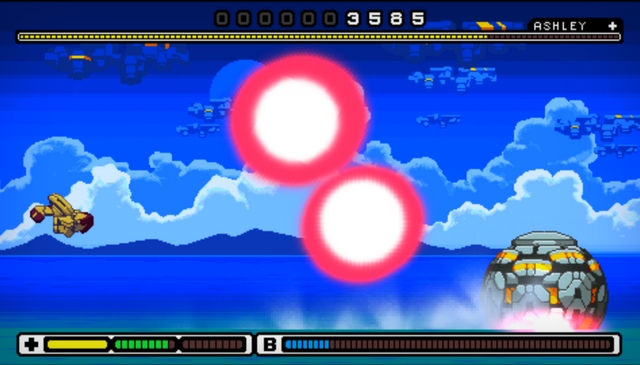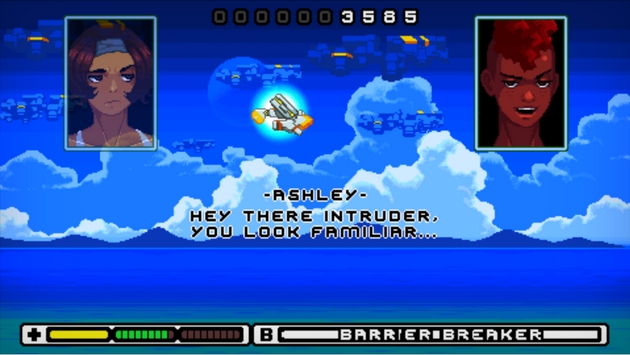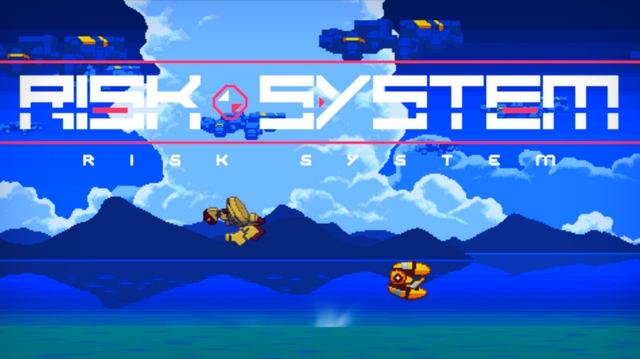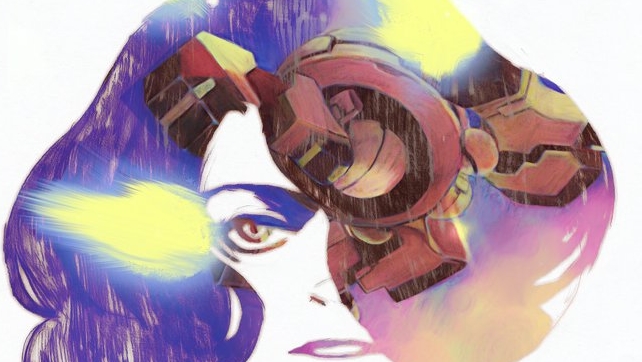Recently, a new demo for the ambitious shmup Risk System was released by developer Newt Industries. With each update, the title boasts new mechanics not seen within the genre. So, to get a real feel for the bold indie title, we got sat down with Chris Ekins, the game’s leader developer — and half of the developer studio.
We got to talk about what’s under the hood for the arcade shooter, as well as look inside the more intimate side of indie game development and its set of unique hurdles.
GameSkinny (GS): When/how did the name Risk System pop into your head for this title?
Chris Ekins (CE): Risk System became the name by means of being a descriptive working title that never ended up changing, similar to Monster Hunter. The game’s systems were all to be about rewarding the risk you take. So the name just ended up sticking.
GS: Can you pinpoint when you realized you wanted to develop your own games?
CE: Playing the original Sonic The Hedgehog in second grade. I used to draw out levels on paper that I’d have my friends “run through” via moving a finger across the page. When they’d encounter an obstacle, I’d hold up the paper to a classroom window so the traps drawn on the other side would become visible.
I didn’t immediately commit to game development as I dabbled in visual art, animation, and music into my 20s. I started teaching myself the programming end in 2010, 2011.

GS: Were there any specific games you looked at as inspiration for it? Those within the genre? Those outside of the genre?
CE: The primary inspirations for Risk System are actually Crazy Taxi and Burnout Takedown. Both games used narrowly missing collisions, risk reward systems in scoring, which I wanted to see applied in other places. I kept the focus of Risk System on movement and improv tied to offense. The closest shmup inspirations would be Einhander and Ikaruga.
There are other shmups that use grazing mechanics, but they’re very adherent to all other genre conventions. At the same time, universal binary movement and alternate fire modes are meant to de-emphasize the need for defensive movement. Because of this, making a game with an emphasis on movement, stunts, and offense is unexplored territory in the genre.
GS: Game development can be rather stressful. When during development, what activities do you participate in to offset that stress?
CE: I’m really bad at self care. I know I need to do better as I’ve been sick for a good 30-40% of Risk System’s development time. When I finally do give in to not working on something for a bit, I like to watch speed runs, play Monster Hunter, or write music on my phone.

GS: You’re a skilled multi-talented artist and game developer. What other hobbies/skills did you incorporate interchangeably when developing?
CE: First, that’s really kind of you, thank you. I write the music for the game and create the sound effects as well. I also contributed some voice acting and built a portable recording booth out of PVC and old blankets to get a fairly noise-free area to work in.
GS: With your latest demo, the music selection changed. Shmups generally use grand, soaring music. Can you explain why you decided to go a different route?
CE: My first approach to the music was almost more like a sci-fi mecha/anime score. It sounded good in isolation or passive listening but it didn’t really hype anyone up the way I thought it would while playing. I rewrote the soundtrack to be more techno/industrial/euro beat/poppy to give the game the kind of pulse you’d find in a racing game.
I also used FM synthesis via Deflemask to create a sound font that was like a hi-bit Genesis/MegaDrive. People have enjoyed the new soundtrack a lot more than the old one, and have had very favorable comparisons to music, which I then went home and got the chance to listen to.
Note: The prior demo featured music which was more ambient in nature. The music is now more pulsating. The change is to emphasize a feeling of engagement instead of passivity.

GS: Recently, you implemented more quality of life features. Can you explain further why and how important it was to have this as an option?
CE: Once I realized that games could be made more accessible, I had to try. The very subject came on my radar when I saw halfCoordinated‘s speed runs. Once you’re aware of that world, you find yourself trying as best you can to make things more accommodating, so more people can experience your work as intended.
The control customization took a very long time due to the age of the engine the game has been constructed in. Currently, I’m working on how to make the game playable without looking at the screen.
Audio-only play was impossible for the first version of the game. This was due to the engine having a limitation on how sounds can be assigned a stereo field position. Now we’re porting the game to a more modern engine as we complete it, so we’re trying to implement all the measures we drafted up to make it possible.
Some sizable speed bumps have been hit, though. Also, it’s looking like if it is going to be possible for this game, we’re going to have to do it as a separate mode. A mode where all collisions are calculated differently (circle based) to work with our sonar system and the enemies will be invisible as to not create hit box dissonance. Other quality of life feedback that we’re implementing is from live events or from our itch.io comments.
Note: halfCoordinated is a speedrunner that plays games one-handed because of hemiparesis. He’s an advocate/consultant for gaming accessibility and a consultant.

GS: From the ace pilot, her commanding officer, and more, all the characters appear to be women. Even in 2018, an entire female cast is rare. Were there any particular influences that inspired the story? Shows, books, etc?
CE: There are two male characters in game, boss three and a background character in the game’s endings, but otherwise, the cast is predominantly women.
Absorbing the works of Kenichi Sonoda as a child probably had a great deal to do with me not even noticing that the game was almost entirely populated by women. The Phantasy Star series, in particular, and other JRPGS in my youth, had a wealth of well-realized and engaging female characters. That sort of set a standard for me, that I wouldn’t realize wasn’t the norm in a lot of places until well into my teens.
I think I just happened to be born at a particular time with a particular make up of friends growing up and into adulthood that these choices didn’t feel very deliberate.
I feel I must acknowledge the fact that I am a man regularly writing stories and making games with women as the main characters. Though there are many women in my life I can run ideas by and defer to/ask for advice, I’m writing from a belief of universality that doesn’t always 100% square up with our lived reality. Everyone in Risk System has the same potential for emotional depth, desires, and faults, as well as the potential to be heroic or a villain regardless of gender.

I tend to write stories in worlds that are much less sexist so this universality of being can exist unimpeded, even though these worlds can still speak to some truth or ill of our own world. The setting of Risk System is kind of like the submarine in 20,000 Leagues Under the Sea, something not yet fully realized at the time of writing but entirely possible and which allows for the story to be told.
I acknowledge that this can be seen as problematic as the world in Risk System doesn’t have institutional sexism or racism built into it, so in that way, it doesn’t resemble our own world. My hope is that in presenting a world such as [this], that is absorbed where it makes sense to players. In that way, my submarine analogy is more apt.
Ending A of the game also carries with it some subtext on the subject. I won’t get into specifics. I want people to be able to feel it on their own and how it may apply to them when they reach it.

GS: The subject of game difficulty is touchy. It either scales, is ruthless from the start, or requires trial and error. How would you describe Risk System’s approach?
CE: The approach for Risk System isn’t to make the challenge a matter of basic survival but of pushing toward mastery. Risk System wants you to become an ace. Death leads right back into a retry so players don’t lost emotional momentum/focus.
Just surviving isn’t terribly difficult but playing well is a challenge and one the game pushes you toward. As long as you’re having fun and experimenting/taking risks, you’re going to get better.
GS: Anything about game development you think would surprise people?
CE: The toll it takes on you physically. I work a separate full-time job and often have to sacrifice sleep in order to get work done. This isn’t out of poor time management but literally having no choice as everything else I have to do to support myself financially takes up so much of any given day — and if I had a healthy sleep schedule, Risk System wouldn’t be out until 2027.
GS: Any idea on a release window?
CE: That’s tough. I absolutely believed it would be out two or three months ago, but illness and working on accessibility options have pushed things back a great deal. Soon. Not too much longer.
Bonus question: What’s your favorite game to wind down with?
CE: At the moment, Monster Hunter World, though I haven’t had time to play for a few months now. Phantasy Star 4 and Phantasy Star Online are both games I like to relax with, too, but currently I don’t have any consoles to play them on hooked up.
We’d like to thank Newt Industries for their insight and helping to fuel our excitement for a release soon. Fans of shmups and challenging games can check Risk System’s newest demo here.








Published: Aug 5, 2018 10:38 am